Ijraset Journal For Research in Applied Science and Engineering Technology
- Home / Ijraset
- On This Page
- Abstract
- Introduction
- Conclusion
- References
- Copyright
Formulation and Evaluation of Herbal Lip Balm
Authors: Miss. Vaishnavi B. Bhande, Prof. Shivprasad S. Deokar
DOI Link: https://doi.org/10.22214/ijraset.2024.63489
Certificate: View Certificate
Abstract
All lip balms, including those referred to as salves or butters are meant to keep lips safe. They have a moisturizing component that stops water loss, such lanolin, shea butter, or petroleum jelly. Lip balm has wax added to help it adhere to lips. Lip balms are products that are put to the lips to shield them from the elements and stop them from drying out. There are a lot of chemical-based lip balms on the market right now from brands like Nivea, Himalaya, Blistex, The Body Shop, and so on. Since lipstick is a cosmetic form akin to lip balm, references to lipstick in the cosmetic literature apply despite the paucity of data on this type of formulation reported in the literature. It is important to distinguish lip balm from lip gloss, as the former is a product meant for use by both sexes. It\'s important to balance the concentration of the primary ingredients, such as butters, oils, waxes, and other excipients, while making lip balms. To guarantee they have healthy, radiant skin, many people look for anti-aging creams, weekly facials, daily skin washes, and a host of other goods.
Introduction
I. INTRODUCTION
The word herbal is a symbol of safety in contrast to the synthetic one which has adverse effects on human health. Herbal preparations viz., herbal tablets, herbal tonics, herbal paste, herbal shampoo, herbal sindhur, herbal contraceptives and herbal lipstick has become popular among the consumer herbal medicines represent the fastest growing segment to heal the various ailments. Possibly, herbal user desire to assume control over health care needs. Perhaps the large in personal healthcare system is unpotable to many and they turn to herbal medicine due to increase side effects of available synthetic preparations, Cosmetics are substances used to enhance the appearance of the human body. Cosmetics include skin-care creams, lotions, powders, perfumes, lipsticks, fingernail and toe nail polish, eye and facial makeup, permanent waves, coloured contact lenses, hair colours, hair sprays and gels the Cosmetics word is derived from the Greek word “Kosmtikos” which means the power, organization and skill in beautifying. The word cosmetics is defined as ‘substances of diverse origin, scientifically compounded and used to cleanse, alleviate skin troubles, cover up imperfections, beautify, and is used in this paper in a wider sense to include oral hygiene as well. Cosmetics have become an integral part of every woman’s life. Cosmetic plays a significant role in today’s life style. Moreover current trend is going green in almost all industries including cosmetics to adopt more natural way of life. The preferable choices are natural food, herbal medicines and natural curing practices for healthy life and also there is much demand for the organic vegetable products. The usage of herbal cosmetics has been increased to many folds in personal care system Natural products have been used for folk medicine purposes throughout the world for thousands of years. Many of them have pharmacological properties such as antimicrobial, anti-inflammatory and cytostatic effects. They have been recognized as useful for human medicine. Herbal extracts are cultivated all over the world and is prime name in horticulture sector. Cosmetics made up of herbal extracts for skin care and hair-care are very popular for their reliability. Herbal cosmetics are products which are formulated using various permissible cosmetic ingredients in which one or more herts are used to provide distinct cosmetic benefits. They are also called as herbal cosmetics. Herbal cosmetics have growing demand in the world market and are an invaluable gift of nature. There are a wide range of herbal cosmetics products to satisfy your beauty regime, adding herbal in cosmetic is very sate for skin. Human being have been using herbs for different purpose like food, medicine, beatifying with advancement of science and technology use of natural things including plant has been reduced except for food, vegetarian takes plant & plant only. However there is resurgence of use of herbs both as drug and cosmetics.
Due to the presence of hazardous synthetic excipients in cosmetics, there has been a great public concern regarding the use of organic sources. Lips do not have any oil glands; thus, it is really important to provide that extra moisture and protection throughout the day. Conventional lip balm often contains petrolatum, synthetic waxes, alumina, paraben, hydrogenated oils and artificial fragrances and colours whichare toxic. Often the lip balm is eaten by the user, thus it becomes major issue for health regulator.
Cosmceuticals are the ingredients that have medicinal properties that benefits topical action and also provide protection against degenerative skin condition.
This work was intended for extensive study of natural lip balm. This was based on the comprehensive literature search of natural lip balm, significance of natural excipients along formulation and evaluation of lip balm. These products are evaluated for organoleptic properties like colour, odour, spread ability, pH, melting point, skin irritation and product consistency. The colour of a product also provides an indication of product quality and freshness. Natural colours are however, less toxic compared to synthetic colours. The present work was carried out by using these ingredients that have less side effects. Products used to protect lips rather than to decorate them are well known as lip balms. They form an adherent, moisture resistant film of oily substances. Usually without any dye.
Beeswax is a natural compound secreted by female bees that is often used in cosmetics, particularly lip balm. This substance is very moisturizing, can help protect the lips from the harmful rays of the sun, and has a pleasant smell. Beeswax act as a natural emulsifier. Vitamin E is an antioxidant and a natural conditioner. Vitamin E helps to maintain the soft, youthful texture of the lips by reducing the signs of aging.
Almond oil penetrates deep into the skin tissue and its fatty acids help to moisturize the lips. The anti-inflammatory properties of almond oil reduce redness and pain associated with chapped and sunburnt lips. Aloe Vera has anti-inflammatory properties that fight irritation. It infuses the lips with antioxidants that fight wrinkles and other forms of skin damage. Beetroot is rich in antioxidants that make the lips soft, supple and improve the elasticity of the skin.
A. What is the Purpose of Lip Balm?
The purpose of all lip balms, even those called salves or butters, is to protect the lips. They contain a moisturizing ingredient(such as petroleum jelly, Shea butter, or lanolin) that prevents water loss. Wax is added to help lip balm stick to lips.
B. What is the History of Lip Balm?
Lip balm was first marketed in the 1880s by Charles Browne Fleet, though its origins may be traced to ear wax. More than 40 years prior to the commercial introduction of lip balm by Fleet, Lydia Maria Child recommended earwax as a treatment for cracked lip sinner highly-popular book, The American
C. Difference Between Lip And Regular Skin Structure:-(12-14)
The lips are more attractive than the regular skin. Generally the top cornea layer of regular skin has 15 to 16 layers mainly for protection purpose. The top cornea layer of the lip contains about only 3 to 4 layers and very thin compared to typical face skin. The lip skin contains very few melanin cells. Because of this, the blood vessels more clearly appear Available online at http://www.urpjournals.com International Journal of Research in Cosmetic Science Universal Research Publications. All rights reserved 2 International Journal of Research in Cosmetic Science 2015; through the skin of the lips that gives a lovely pinkish colour of the lips. The lip skin has no hair follicle and no sweat glands. Therefore it does not have the sweat and body oil in protecting the lip from outside environment.
D. Anatomy of Lips

The lips serve as organs of pretension, suction and speech. It is composed of the skin, superficial fascia, orbicular is muscle and the muscles inserted around it (areola tissue & mucous membrane). The margins of the lips are covered with dry, red mucous membrane, continuous with the skin and containing numerous vascular papillae and touch corpuscles. The mucous membrane internally is reflected from the upper and lower lip upon the gums,and in the median line forms two folds of superiors and inferiors. The areola tissue or sub mucous layer contains the coronary vessels which completely encircle the buckle orifice near the free margin of the lips.
The coronary vessels are the superior and inferior coronary arteries which arise from the facial. The superior coronary is larger than the inferior, and anatomises with its fellow of the opposite side and gives off a small artery to the septum arteriaseptinasi. Compression of this artery will sometimes control nasal haemorrhage. The superior labial or coronary vein begins as a plexus in the orbicular is muscle of the upper lip, passes with the coronary artery and drains into the facial vein a little below the aloe of the nose of the veins which drain the lower lip the inferior coronary empties into the facial a little below the superior labial; but the chief branch from the lower lip descends as a rule to the sub mental vein, thence to the facial or often to the anterior jugular. The nerves supplying the lower lip are derived from the mental who emerges from the bone through the mental foramen and sends large twigs to the mucous membrane, the integument and the fascia of the lip and chin. Some of the lymphatic vessels of the lips pass to a gland just above the body of the hyoid bone, while others pass to the sub maxillary glands.
E. Lip Disorders:-(15-19)
- Swelling: An allergic reaction can make the lips swell. The reaction may be caused by sensitivity to certain foods or beverages, drugs, lipstick, or airborne irritants. When a cause can be identified and then eliminated, the lips usually return to normal. But frequently, the cause of the swelling remains a mystery. A condition called hereditary angioedema may cause recurring bouts of swelling. Nonhereditary conditions such as erythematicmultiform, sunburn, cold and dry weather, or trauma may also cause the lips to swell.
- Sun Damage: Sun damage may make the lips, especially the lower lip, hard and dry. Red speckles or a white filmy look signal damage that increases the chance of subsequent cancer. This type of damage can be reduced by covering the lips with a lip balm containing sunscreen or by shielding the face from the sun's harmful rays with a wide-brimmed hat.
- Inflammation: With inflammation of the lips (cheilitis), the corners of the mouth may become painful, irritated, red, cracked, and scaly. Cheilitis may result from a deficiency of vitamin B2 in the diet.
- Discoloration: Freckles and irregularly shaped brownish areas (melanotic macules) are common around the lips and may last for many years. These marks are not cause for concern. Multiple, small, scattered brownish black spots may be a sign of a hereditary disease called Peutz-Jeghers syndrome, in which polyps form in the stomach and intestines. Kawasaki disease, a disease of unknown cause that usually occurs in infants and children 8 years old or younger, can cause dryness and cracking of the lips and reddening of the lining of the mouth
- Sores: A raised area or a sore with hard edges on the lip may be a form of skin cancer. Other sores may develop as symptoms of other medical conditions, such as oral herpes simplex virus infection or syphilis. Still others, such as keratoacanthoma, have no known cause.
F. Application of Lip Balm :-(30-32)
Lip balms are formulations applied onto the lips to prevent drying and protect against adverse environmental factors. Numerous lip balms of chemical origin are currently available in the market from companies like The body shop, Nivea, Himalaya, Blistex, etc. The cosmetic literature reports limited data on this type of formulation, although references related to lipstick apply because it is a cosmetic form similar to lip balm. This similarity extends to include organoleptic and stability requirements such as resistance to temperature variations, pleasant taste, innocuousness, smoothness during application, adherence and easy intentional removal. Lip balm should not be considered equivalent to the lip gloss, with the former being a product intended for use by both men and women. To formulate lip balms, it is necessary to balance the concentration of the main ingredients including butters, oils and waxes and other excipients. Many people seek weekly facials, daily skin scrubs, anti-aging lotions, and many other products to ensure they have healthy and glowing skin. But with all the attention being given to healthy skin, lip care is largely forgotten. Natural lip balms offer a natural way to maintain and promote healthy lips. Lip balms are often eaten away by the user and hence it is imperative that health regulators have a microscopic look at the ingredients that go in to the lip balm. The dyes that contribute to the colour of the lip.
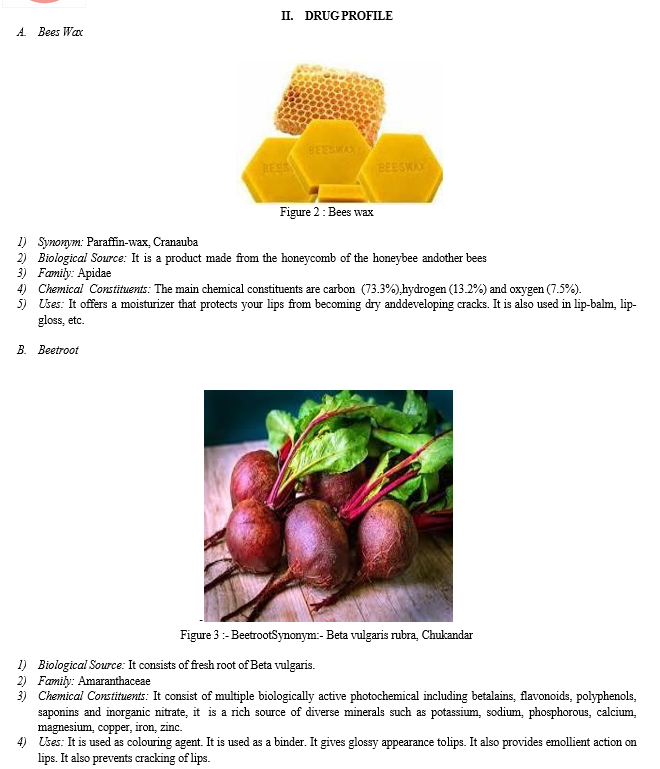
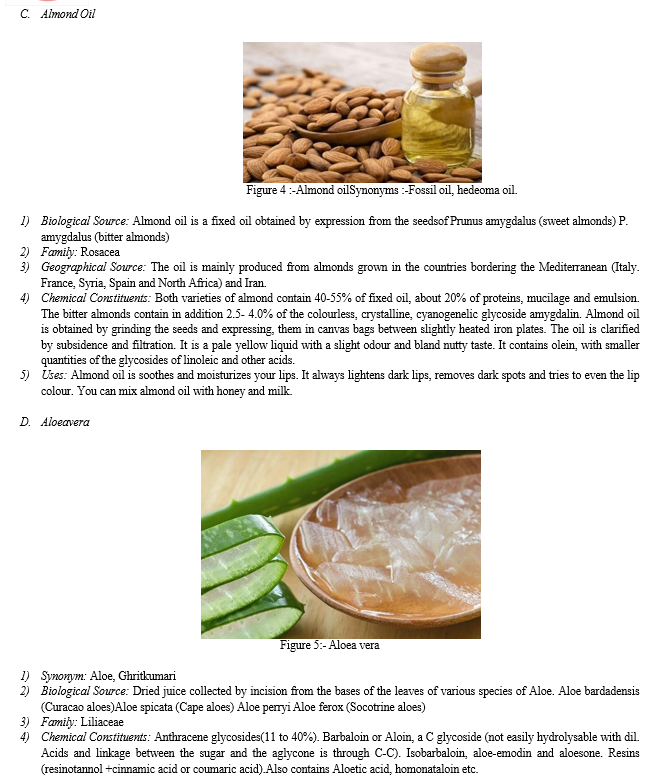

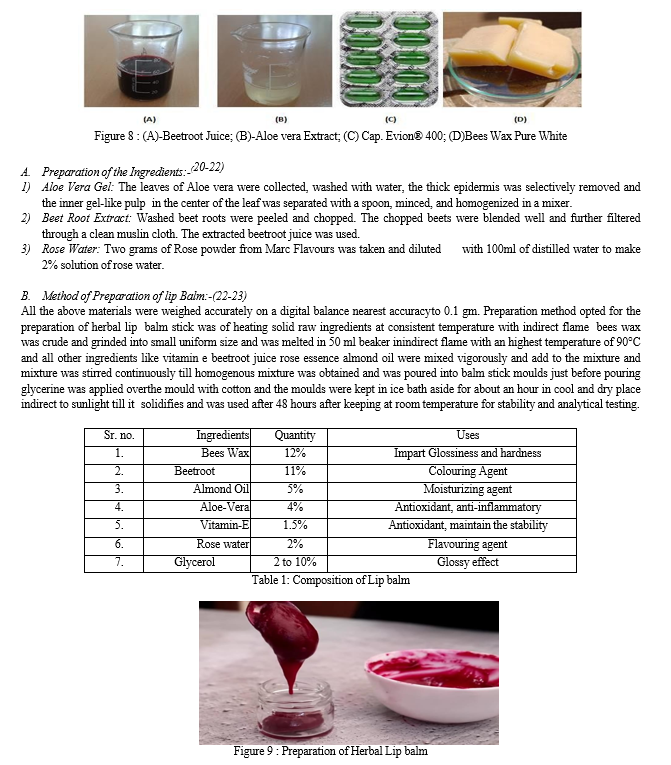
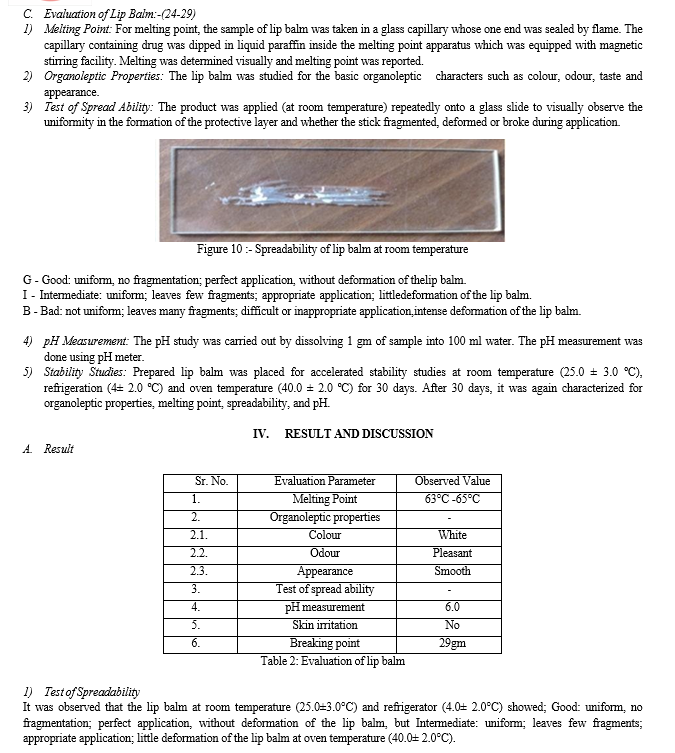
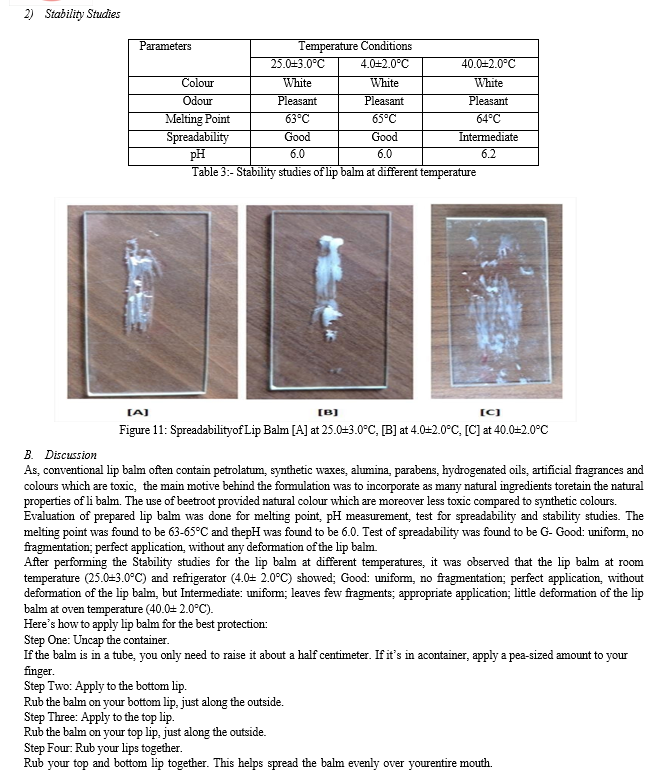
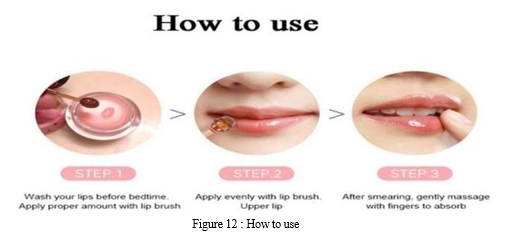
Conclusion
The formulation stored at room temperature and refrigerator showed same stability behaviour. The organoleptic characteristics were stable and spread ability was found to be \"Good\". Storage under these conditions was considered to be adequate, because the product functionality was maintained. During the stability test, the lip balm made from natural ingredients showed and appropriate melting point (mean of 64°C). According to the test of spread ability, the storage condition of oven (40.0± 2.0°C) is not recommended because of loss of product functionality when compared with the normal stability test. It was concluded that lip balm made from natural ingredients is safe to use and this combination proved to be better option in formulation of a lip balm. By alteration of the excipients or further combinations of the excipients can result in a new formulation with a different and enhanced quality. From the current studies it was predicted that the formulation will remain stable.
References
[1] Kaul S, Dwivedi S. Indigenous ayurvedik knowledge of some species in the treatment of human disease and disorders. Inter J Pharm and Life Sci 2010;1 (1):44-49. [2] Dwivedi S, Dwivedi A, Dwivedi SN. Folklore uses of some plants by the tribal are of Madhya Pradesh with special reference to their conservation. Ethno botanical Leaflets. 2008; 12: 74 1-743. [3] Pandit Deepika, Gujrati Aditi, Rathore K S, “Formulation and Evaluation of Herbal Lipstick from the Extract of Papaya”, International Journal of Pharmaceutical Science, July-August 2020; 63(1): 107-110. [4] B.H. Ali, N.A. Wabel, G. Blunden, Phytochemical, pharmacological and toxicological aspects of Hibiscus sabdariffa L.: a review. Phytother Res. 19 (2005)369-375. [5] 12. M.S. Balsam, E. Sagarin, Cosmetics science and technology, Second ed. Wiley Interscience Publication, NY, USA, 2008, 3, pp.209-512. [6] Fernandes AR, Dario MF, Stability evaluation of organic lip balm. Brazilian Journal of Pharmaceutical Sciences, 2013: 49;293-300. [7] Mayuri Kadu, Dr Suruchi Vishwasrao, and Dr Sonia Singh, A Review on Natural Lip Balm. International Journal of Research in Cosmetic Science. 03 August 2014. ISSN2277–7172. A.R. Fernandes, M.F. Dario, C.A.S.O. Pinto, T.M. Kaneko, A.R. Baby, M.V.R. Velasco, Stability evaluation of organic Lip Balm, Braz. J. Pharm. Sci. 2 (2013)49. [8] Savalkar M.B. et al. Formulation & Evaluation of Herbal lipstick using Amaranthus dubius, J. Pharm. Res., 2018, 7(6),96-98. [9] P. L. Kole, H. R. Jadhav, P. Thakurdesai, A. N. Nagappa, Cosmetic products of herbal extracts, Natural Product Radiance. 4 (2005)4. [10] Grindlay D, Reynolds T. The Aloe vera phenomenon: A review of the properties and modern uses of the leaf parenchyma gel. J Ethnopharmacol. 1986;16:117–51. [11] Kokate CK, Purohit AP, Gokhale SB. Textbook of Pharmacognosy. 49th ed. Pune: Nirali Prakashan, 2014. [12] Medscape. http://emedicine.medscape.com/article/835209-overview (assessed on 8 January 2015) [13] http://elementsofmorphology.nih.gov/anatomy-oral.shtml (assessed on 8 January 2015) [14] M.S. Balsam, E. Sagarin, Cosmetics science and technology, Second ed. Wiley Interscience Publication, NY, USA, 2008, 3, pp. 209-512. [15] M.S. Balsam, E. Sagarin, Cosmetics science and technology, Second ed. Wiley Interscience Publication, NY, USA, 2008, 3, pp. 209-512. [16] Lip Disorders Lip and Tongue Disorders Merck Manual Home Edition.mht http://www.merckmanuals.com/home/mouth_and_dental_disorders/lip_and_to ngue_disorders/lip_disorders.html (assessed on 30 November 2014) [17] M.G. Denavarre, The chemistry and manufacture of cosmetics, Second ed., Continental Press: Orlando, USA, 1975, 3, pp. 699. [18] A.R. Fernandes, M.F. Dario, C.A.S.O. Pinto, T.M. Kaneko, A.R. Baby, M.V.R. Velasco, Stability evaluation of organic Lip Balm, Braz. J. Pharm. Sci. 2 (2013) 49. [19] S. Deshmukh, M. Chavan, M. Sutar, S. Singh, Preparation and evaluation of natural lipsticks from bixaorellana seeds, Int J Pharm Bio Sci. 4 (2013) 139- 144. [20] Abdul Wadood Khan, Sabna Kotta, Shahid Hussain Ansari, Rakesh Kumar Sharma, Amit Kumar and Javed Ali, Formulation development, optimization and evaluation of aloe vera gel for wound healing. Pharmacogn Mag. 2013 Oct-Dec; 9(Suppl 1): S6–S10. doi:10.4103/0973-1296.117849 [21] Mona Patel, Ojash Patel, formulation and evaluation of herbal lipstick using beta vulguris extract. International ayurvedic medical journal. June2021. [22] S. Deshmukh, M. Chavan, M. Sutar, S. Singh, Preparation and evaluation of natural lipsticks from bixaorellana seeds, Int J Pharm Bio Sci. 4 (2013)139- 144. [23] Kadu M, Singh V. Review on natural lip balm International Journal of Research in Cosmetic Science 2015; (1):1-7. [24] Sharma PP, cosmetics- Formulation, manufacturing and quality control, Edn5.Vandana publications, Delhi, 2008,297-313. [25] H. Ratih, H. Titta, C.P. Ratna, Formulation of Cananga Oil Lip Balm as Emolient”. ProsidingSimposiumPenelitianBahanObatAlami (SPBOA) XIV dan Muktamar XII PERHIPBA2014. Yogyakarta: Leutikaprio. p. 3,2014. [26] P.P. Sharma, “Cosmetics-Formulation, manufacturing and quality control”, fourth ed. (2008). Vandana Publications Pvt.Ltd.,India. [27] H. I. N. Nasution, “Formulation of Lip Balm using Combination of Palm Kernel Oil (PKO) and Red Palm Oil (RPO) as Lip Moisturizer,” Final project, Universitas Sumatera Utara,2018. [28] BRASIL. Ministério da Saúde. Agência Nacional de VigilânciaSanitária. SériesTemáticas: Qualidade 1. Guia de Estabilidade de produtoscosméticos. Brasília, v.1, 2004. 45p. [29] OLIVEIRA, F.O. Contribuição da análisetérmica no desenvolvimento de formulações de batons. São Paulo, 2003. 85 p. [Dissertation of Master degree. Institute of Chemistry. University of São Paulo]. [30] M.G. Denavarre, The chemistry and manufacture of cosmetics, Second ed., Continental Press: Orlando, USA, 1975, 3, pp. 699. [31] A.R. Femandes, M.F. Dario, C.A.S.O. Pinto, T.M. Kaneko, A.R. Baby. M.V.R. Velasco, Stability evaluation of organic Lip Balm, Braz J. Pharm. Sci. 2 (2013) 49. [32] S. Deshmukh, M. Chavan, M. Sutar, S. Singh, Preparation and evaluation of natural lipsticks frombixaorellana seeds, Int J Pharm Bio Sci. 4 (2013) 139- 144.
Copyright
Copyright © 2024 Miss. Vaishnavi B. Bhande, Prof. Shivprasad S. Deokar. This is an open access article distributed under the Creative Commons Attribution License, which permits unrestricted use, distribution, and reproduction in any medium, provided the original work is properly cited.

Download Paper
Paper Id : IJRASET63489
Publish Date : 2024-06-28
ISSN : 2321-9653
Publisher Name : IJRASET
DOI Link : Click Here
 Submit Paper Online
Submit Paper Online

